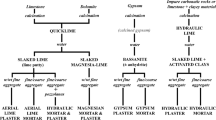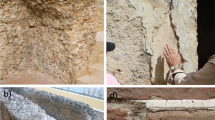Abstract
The practical aspects of sampling of historic mortars are dependent on external factors, such as conservation philosophy, which can constrain sampling activity, and/or laboratory analysis, which offer the answers to questions posed by an investigation. However, the utility of conclusions reached depends on the quality, and the relevance, of the samples taken for answering these questions. Two major controls operate on sampling practice; the objectives of an investigation and the analyses (physical, chemical or descriptive) needed to fulfil the objectives. A clear statement of the problems being investigated is needed and the full context of the investigation must be outlined before samples are taken. This can be achieved by structured recording of building characteristics, including the construction history of the building or “stratigraphy”, decay states and the materials used. Visual analysis is a powerful and cost effective method of investigating problems, material variations and for selecting locations for sampling, if suitably experienced personnel are employed. Hypotheses can be formulated as to the cause of damage or the academic subject under study. Then specific sampling targets can be identified with knowledge of the variability of the materials available and the hypotheses to be tested. Laboratory and field analyses use a variety of instrumental techniques that each have minimum sampling requirements. The problems to be accommodated in standardising sampling practice include acces to structures, acceptance of those trusted with sampling and the variability of reasons for sampling.
Résumé
Les aspects pratiques d'échantillonnage des mortiers historiques dépendent des facteurs externes, comme l'analyse en laboratoire, qui donnent les réponses aux questions posées par la recherche. Néanmoins, l'utilité des conclusions dépend de la qualité et de la pertinence des échantillons. La mise en œuvre de l'échantillonnage dépend de deux facteurs: les objectifs de la recherche et les analyses (physiques, chimiques ou descriptives) nécessaires pour répondre aux objectifs. Une explication claire des problèmes examinés est nécessaire et le contexte global de la recherche doit être bein délimité avant la prise des échantillons. La délimitation est possible par l'enregistrement structuré des caractéristiques du bâtiment, comme l'histoire de la construction du bâtiment («stratigraphie”), les dégâts et les matériaux utilisés. L'analyse visuelle est une méthode puissante et effective pour l'examen des problémes, les variations des matériaux et pour la sélection des localisations pour l'échantillonnage, si elle réalisée par des personnes expérimentées. Des hypothèses peuvent être formulées sur l'origine des dégâts ou sur le sujet académique qui est étudié. Puis, des buts spécifiques pour l'échantillonnage peuvent être identifiés avec connaissance de la variabilité des matériaux présents et des hypothèses à tester. Des analyses en laboratoire ou in-situ utilisent une variété de techniques instrumentales qui ont chacune des exigences minimales. Les problèmes qui doivent s'accommoder dans la standardisation de l'échantillonnage contiennent l'accès aux structures, l'acceptation de toutes les parties concernées et la variabilité des raison d'échantillonnage.
Similar content being viewed by others
References
van Hees, R., ‘Damage Diagnosis and compatible repair mortars’, in “Historic Mortars: Characteristics and Tests”, Bartos, P. J. M, Groot C. J. W. and Hughes J. J. (eds.), Proceedings of the RILEM International Workshop, Paisley, Scotland May 1999, (RILEM 2000), 27–35.
van Hees, R., ‘Masonry damage Diagnostic System’, RILEM TC 167-COM Document 97-14.
Baronio, G. and Binda, L., ‘Experimental approach to a procedure for the investigation of historic mortars', in the Proceedings of the 9th International Brick/Block Masonry Conference, Berlin, 1991.
Schouenborg, B., Lindqvist, J. E., Sandström, H. Sandström, M., Sandin, K. and Sidmar, E., ‘Analysis of old lime plaster and mortar from Southern Swede-A contribution to the Nordic seminar on building limes’, Swedish National Testing and Research Institute, Building Technology, SP Report 1993:34.
Knöfel, D. and Schubert, P., ‘Mortars and stone replacement materials for the use in the restoration of historic buildings’ (in German, “Mörtel und Steinerganzungsstoffe in der Denkmalpflege”) (Verlag Ermst & sohn Berlin 1993).
Jedrzejweska, H., ‘Ancient mortars as criterion in analysis of old architecture”, in “Mortars cements and grouts used in the conservation of historic buildings“, Proceedings of the ICCROM Symposium, Rome, 1981, 311–329.
Cheeney, R. F., “Statistical Methods in Geology’, (George Allen & Unwin, London, 1983).
Author information
Authors and Affiliations
Additional information
Editorial Note This paper has been extensitvely discussed in RILEM TC 167-COM: ‘Characterisation of old mortars with respect to thier repair‘, chaired by Caspar Groot.
Rights and permissions
About this article
Cite this article
Hughes, J.J., Callebaut, K. In-situ visual analysis and practical sampling of historic mortars. Mat. Struct. 35, 70–75 (2002). https://doi.org/10.1007/BF02482103
Issue Date:
DOI: https://doi.org/10.1007/BF02482103




